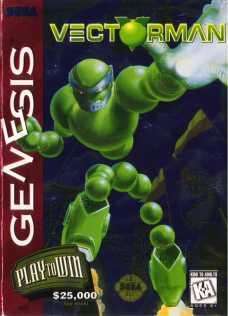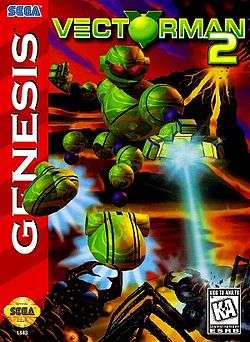Vectorman
| Vectorman | |
|---|---|
 North American cover art | |
| Developer(s) | BlueSky Software |
| Publisher(s) | Sega |
| Designer(s) |
Rich Karpp Mark Lorenzen |
| Composer(s) | Jon Holland |
| Platform(s) | Sega Mega Drive/Genesis, Mobile phone, Virtual Console, Windows (via Smash Pack, Steam and GameTap), PlayStation 2, PlayStation Portable (both via Sega Genesis Collection) |
| Release date(s) |
Mega Drive/Genesis Virtual Console |
| Genre(s) | Action/platform game |
| Mode(s) | Single-player |
Vectorman is a series of run and gun platform games developed by BlueSky Software and published by Sega for the Sega Mega Drive/Genesis. The first game in the series was released on October 24, 1995 in North America[1] and on November 30, 1995 in Europe. The games have since appeared on several game compilations, including the Sega Genesis Collection for the PlayStation 2 and PlayStation Portable, the Sonic Gems Collection for the Nintendo GameCube, and Sonic's Ultimate Genesis Collection for Xbox 360 and PlayStation 3. Vectorman was added to the Wii Virtual Console on February 27, 2007, in Japan and April 5, 2007, in Europe, and in North America on September 22, 2008.[2] It was also released on the digital distribution service Steam as part of the "SEGA Genesis Classics Pack" and as a standalone title.
Story
Vectorman
In 2049, the human population of Earth embarks on a migratory voyage to try to colonize other planets. They leave mechanical "orbots" to clean up the mess they made on Earth through littering and pollution. Raster, a high-level orbot who watches Earth through a planetwide computer network, is accidentally attached to a working nuclear missile by a lesser orbot and goes insane, becoming an evil dictator named Warhead. He declares himself ruler of Earth, and begins preparing to execute any humans who dare return to their planet.
Enter Vectorman, a humble orbot in charge of cleaning up toxic sludge by simply discharging it into the sun. As he lands on Earth after his last trip, he finds chaos and confusion. Because all the other Orbots are controlled by Warhead (Vectorman having not been affected because he was away), Vectorman takes it upon himself to destroy the errant orbot and restore peace to Earth.
Vectorman 2
After saving Earth from Warhead in the previous game, Vectorman's sludge barge is targeted and destroyed by a missile. Vectorman escapes, parachuting down to the planet to battle with the Earth's multitudinous enemy; mutant insects. Now it is up to Vectorman to fight through the mutant bugs and find the most fearsome source infestation; the evil Black Widow Queen.
| Vectorman 2 | |
|---|---|
 Box art | |
| Developer(s) | BlueSky Software |
| Publisher(s) | Sega |
| Producer(s) |
Jerry Markota Jerry Huber |
| Designer(s) |
John Abad Marty Davis Keith R. Freiheit Jerry Huber Rick Randolph Rick Schmitz Ron Thompson Thi Truong Jason Weesner Dok Whitson |
| Platform(s) | Mega Drive/Genesis, PlayStation 2, PlayStation Portable (both via Sega Genesis Collection), Xbox 360, PlayStation 3 (both via Sonic's Ultimate Genesis Collection), Windows (via Smash Pack) |
| Release date(s) |
|
| Genre(s) | Run and gun |
| Mode(s) | Single-player |
Graphics and gameplay
Vectorman
Vectorman uses pre-rendered 3D models in its level and character designs. This gives the game a smooth, computer-generated feel. The original name of the villain, Warhead, was Raster (as in raster graphics, the opposite of vector graphics). Vectorman was considered the answer to Nintendo's Donkey Kong Country at the time, as they both used graphical tricks to show graphics beyond what the console was thought capable of.
The game itself is a straightforward 2D action platformer. Vectorman is an "orbot" (a robot whose body is composed entirely of orbs) powered with a ball gun in his hand; powerups include a machine gun, "bolo" gun, and triple-fire guns.
Vectorman possesses the ability to transform, through the use of powerups, into several different forms: including a drill, to cut through floors; a bomb, to destroy all surrounding enemies or breakable walls; and an aquatic form, useful for swimming underwater. In addition to powerup transformations, three levels host unique morphed forms with which to combat bosses in. Overall, the game consists of 16 levels.
"Play to Win" contest
Sega held a "Play to Win" promotion offering Vectorman players a chance to win $25,000 as well as numerous other prizes, including several $10,000 prizes, and free Sega Saturn consoles. Upon completing the game (without using cheat codes), select Vectorman cartridges would display a flashing "You Win!" message with a special phone number where the player could call in and register as a winner. 12- year old "Keola" Kaula of Albuquerque, New Mexico, was the winner of the grand prize, which included $25,000, a VIP tour of Sega headquarters, and a starring role in a Sega TV commercial.[3]
Vectorman 2
The gameplay is similar to the previous game. Vectorman has a different set of weapons, including a pulse beam, energy shot, and supershot guns. Vectorman can also now transform into insect forms such as a fire ant, a rhino, and "shield bug" that repels attacks. Unlike the original Vectorman, the full-level transformations featured in this game are not used to combat bosses as that is left to the human-form Vectorman. There are 22 levels divided into seven parts in all.
Before Vectorman 2 was released, Sega Channel held a contest that allowed artists to draw a morph Vectorman. Judges then chose the best one to be transformed in Genesis art, as well as being put on the Sega Channel. Ten runner-up submitters won a copy of Vectorman 2.[4]
Reception
The four reviewers of Electronic Gaming Monthly gave the first Vectorman a score of 8.25 out of 10, unanimously praising the advanced graphics and animation, large levels with numerous hidden areas, strong audio, and ability to change into different forms.[5] They later awarded it Best Sega Mega Drive Game of 1995.[6] GamePro gave it a rave review, stating that "your jaw will hang open in amazement at what Vectorman does with the 16-bit Genesis engine. This platform game comes on with great guns, a morphing hero, and diverse, well-detailed levels." They also praised the simple controls, advanced graphics, and sound effects.[7]
Canceled third game
Although BlueSky Software, the developer of both Vectorman games, closed in 2001, a Vectorman game for the PlayStation 2 was announced in 2003 but was soon cancelled.[8] It would have been an action game with platforming elements. The main character would have been overhauled, receiving a vastly different design and a tinny and mechanical voice.
References
- ↑ Sega begins 24-hour countdown to "Vectormania"
- ↑ "Two WiiWare Games and Two Virtual Console Games Added to Wii Shop Channel". Nintendo of America. 2008-09-22. Retrieved 2008-09-22.
- ↑ http://www.thefreelibrary.com/12-year-old+gamer+wins+$25,000+cash+grand+prize+in+Sega%27s+videogame...-a017793447
- ↑ "Sega Channel Memories pt2". 2007-06-10. Retrieved 2010-02-17.
- ↑ "Review Crew: Vectorman". Electronic Gaming Monthly. Ziff Davis (76): 42. November 1995.
- ↑ "Electronic Gaming Monthly's Buyer's Guide". Electronic Gaming Monthly. 1996.
- ↑ "ProReview: Vectorman". GamePro. IDG (86): 70–71. November 1995.
- ↑ Dunham, Jeremy (2003). "Sega Rumor Clarification". IGN.com. Retrieved 2007-08-07.
External links
- Game Profile at OverClocked ReMix - Fan ReMixes of Vectorman soundtrack and composer information